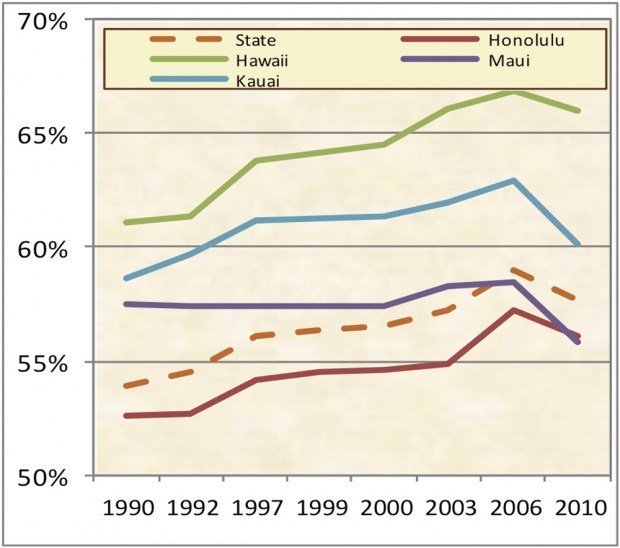LIHU‘E — A comprehensive statewide housing study presented to Kaua‘i County Council on Wednesday reveals burdensome real estate market for island residents, with a third of them at risk of becoming homeless. “Hawai‘i — and Kaua‘i — has one of
LIHU‘E — A comprehensive statewide housing study presented to Kaua‘i County Council on Wednesday reveals burdensome real estate market for island residents, with a third of them at risk of becoming homeless.
“Hawai‘i — and Kaua‘i — has one of the highest-priced housing markets in the United States,” said James Dannemiller, executive vice-president of SMS Research and Marketing Services, which created the report.
SMS recently released the Hawai‘i Housing Planning Study 2011, the fifth such all-encompassing housing study the company has prepared since 1992.
Dannemiller said several factors contribute to Hawai‘i’s high real estate prices. The state has the second or third highest construction costs in the nation, the land is expensive and the average wages and household incomes are high.
Also, despite Hawai‘i having the most regulated housing market in the nation, there are many market advantages here, and the state spends more than anyplace else in the country telling people about those advantages.
The cumulative result: Hawai‘i has the lowest ownership rate in the country, one of the highest crowding rates nationwide and the fourth highest homeless rate among the 50 states and the District of Columbia.
To cope with those issues, or as it has been planned, Hawai‘i’s housing market has a “very high” rate of multi-family uses, a “relatively high rate” of leasehold residential properties, a “relatively high quality” housing stock and a “very low rate” of non-standard housing units, according to the study.
The study states that homelessness has roots in poverty and in housing stock.
About 25 percent of all households statewide are at risk of becoming homeless. On Kaua‘i, this number is almost doubles.
Dannemiller said that the Garden Isle housing market has caused 36 percent of households at risk of homelessness. Those numbers climb to 50 percent, if only Waimea District is considered. Hanalei trails in second place at 39 percent. In Koloa, Lihu‘e and Kawaihau districts, the homelessness risk fluctuates between 34 and 35 percent.
The study found that 20 percent of homeowners and renters on Kaua‘i said they would become homeless if they were forced to move out and had no place to live, 43 percent would seek help, 34 percent would figure out other resources and 3 percent didn’t know or refused to answer.
Living situation
Out of 23,201 households on Kaua‘i in 2011; about 10 percent are crowded (more than 1.01 persons per room) and 11 percent are doubled-up (more than one family in a single house). About 16.9 percent of households are both crowded and doubled-up. Nearly 10 percent of households have “hidden homeless” persons, meaning a friend or family member is living in the home for a few months because they have no other place to stay.
About 15,536 households are not interested in moving, and 7,489, or 27.3 percent of households, would be interested in moving to a different home. A small percentage belongs to out-of-state homeowners.
Despite nearly one third of households willing to move, this number has dropped steadily since the first time the study was done. In 1992, nearly 39 percent of households were interested in moving to a different unit. In 1997, the number dropped to 34.2 percent, in 2003 it was 31.4 percent and in 2006 it was 30.6 percent.
Rent or own?
The median sales price on Kaua‘i in 2011, obtained from Multiple Listing Service, was $415,000. A home at that price would generally require an $81,000 down payment and monthly payments of approximately $1,771, depending on loan rates, points and terms.
By comparison, in Honolulu County the median sales price in 2011 was $570,000, in Maui County it was $415,000 and on the Big Island it was $224,500.
Dannemiller said that on Kaua‘i only 5 percent of renters would rather rent than own a home, and approximately 4 percent lack confidence to go into home-ownership. About 69 percent of renters would buy a home but have not done so because the housing prices are high, and about 23 percent of renters would buy a home but their current financial situation would not allow them to qualify for a loan.
Affordable living
In 2003 the median rent on Kaua‘i was $1,300. That number climbed until mid-2007, when it peaked at approximately $1,750. Since then, a steady decline has brought the number down to about $1,400 in 2010. But Dannemiller said that when data from 2011 comes in by mid-year, the average price of rentals on Kaua‘i should go up.
In order to be able to afford a comfortable life, Dannemiller said it is optimal that 30 percent or less of a household’s income be spent on shelter (rent or mortgage). About 39 percent of household incomes on Kaua‘i are on or bellow those numbers.
Spending between 30 and 40 percent of household income on shelter puts stress and pressure on households, according to Dannemiller. About 14 percent of Kaua‘i’s households fall in that bracket.
When over 40 percent of the household income is spent on shelter, families could have a “very difficult life,” Dannemiller said. Approximately 28 percent of households on the island are in that category — in different parts of the island those numbers go roughly from 24 to 27 percent of households, with the exception of Hanalei, where 35 percent of households pay 40 percent or more of their income for shelter.
Visit hawaii.gov/dbedt/hhfdc for more information and to download the entire study.


